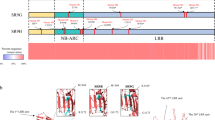Abstract
Three mutants selected from a population of sugarcane clone H54-775 that had been irradiated with 3 kR γ-radiation all lacked toxin-binding protein activity. This activity previously had been shown to be essential for eye spot disease susceptibility and was demonstrated in the susceptible parent clone H54-775. In one mutant, the biochemical, immunochemical, and electrophoretic mobilities of the toxin-binding protein were all modified.
Similar content being viewed by others
References
Lowry, O. H., Rosebrough, J. G., Farr, A. L., and Randall, R. (1951). Protein measurement with the Folin phenol regent. J. Biol. Chem. 193265.
Nair, M. K. (1973). Note on an induced red rot resistant mutant of “CO 997” varieties of sugarcane. Indian J. Agr. Sci. 43323.
Ornstein, L., and Davis, B. J. (1962). Disc Electrophoresis, Distillation Products Industries, Eastman Kodak Co., 62 pp.
Rao, J. T., Srinivasan, K. U., and Alexander, K. C. (1966). A red-rot resistant mutant of sugarcane induced by gamma irradiation. Proc. Indian Acad. Sci. 64224.
Steiner, G. W., and Byther, R. S. (1971). Partial characterization and use of a host-specific toxin from Helminthosporium sacchari. Phytopathology 61691.
Steiner, G. W., and Byther, R. S. (1974). Heat induced resistance to helminthosporoside. Am. Phytopathol. Soc. Abstr., No. 68.
Steiner, G. W., and Strobel, G. A. (1971). Helminthosporoside, a host-specific toxin from Helminthosporium sacchari. J. Biol. Chem. 2474350.
Strobel, G. A. (1973a). The helminthosporoside binding protein of sugarcane: Its properties and relationship to susceptibility to the eye spot disease. J. Biol. Chem. 2481321.
Strobel, G. A. (1973b). Biochemical basis of the resistance of sugarcane to the eye spot disease. Proc. Natl. Acad. Sci. 701693.
Strobel, G. A. (1974). The toxin-binding protein in sugarcane, its role in the plant and in disease development. Proc. Natl. Acad. Sci. 714232.
Strobel, G. A., and Hess, W. M. (1974). Evidence for the presence of the toxin-binding protein on the plasma membrane of sugarcane cells. Proc. Natl. Acad. Sci. 711413.
Watanabe, S., Okada, Y., and Kitagawa, M. (1967). Immunochemical studies on cytochrome E. J. Biochem. (Tokyo) 62150.
Author information
Authors and Affiliations
Additional information
The work reported here was supported in part by Grant GB 43192 from the National Science Foundation and Grant C145-2575 from the Cooperative States Research Service of the United States Department of Agriculture and the Hawaiian Sugar Planters' Association, Honolulu, Hawaii; Montana Agricultural Experiment Station, Paper No. 579, Journal Series, and Paper No. 370, Journal Series of the Experiment Station, HSPA.
Rights and permissions
About this article
Cite this article
Strobel, G.A., Steiner, G.W. & Byther, R. Deficiency of toxin-binding protein activity in mutants of sugarcane clone H54-775 as it relates to disease resistance. Biochem Genet 13, 557–565 (1975). https://doi.org/10.1007/BF00484915
Received:
Revised:
Issue Date:
DOI: https://doi.org/10.1007/BF00484915




